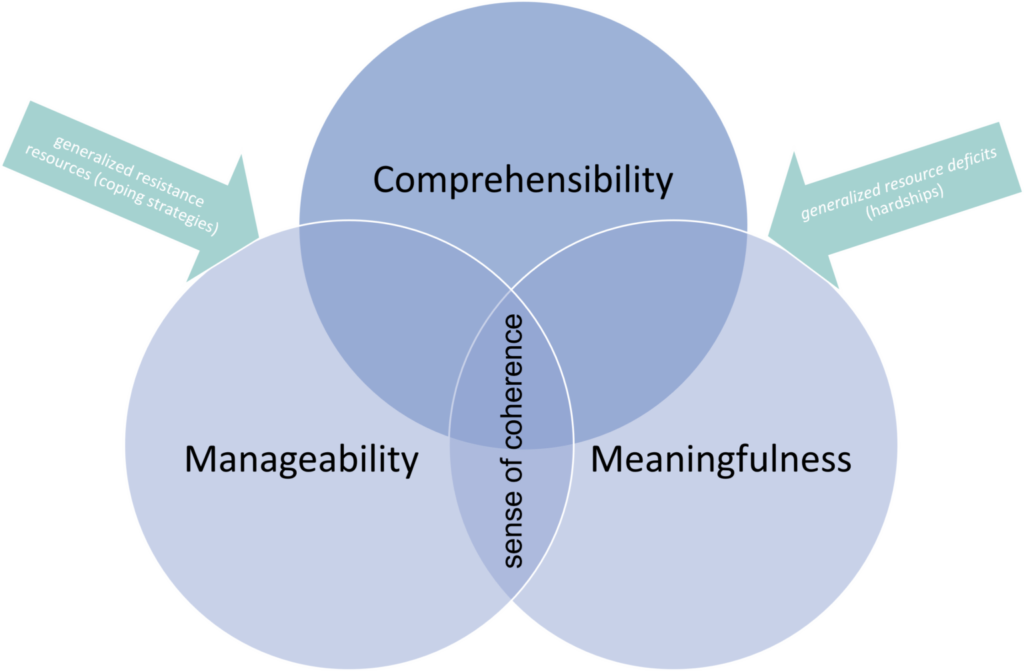Home » SALUTOGENESIS – CONTROLLING HEALTH AND STRESS IN A SELF-DETERMINED WAY

SALUTOGENESIS
Controlling Health and Stress in a self-determined way
What would actually happen if we focused on maintaining health instead of curing diseases? This is the approach of Aaron Antonovsky’s concept of salutogenesis. In this blog article, we would first like to briefly introduce and explain the model to you and then give you some specific ideas on how you can actively do something about stress based on this model and take your health into your own hands!
Salutogenesis – a model to better understand the components of Health
The model of salutogenesis according to Aaron Antonovsky (1923-1994) is a central theory in health practice, especially in the field of health promotion. He set it up as a counter-design to the focus on the question of how diseases arise and how they can be treated (pathogenesis). The core question of salutogenesis is how health actually is created and how people can actively promote it and better deal with risks and stressors. The model of salutogenesis, which to date does not claim to be complete, but has served as the basis for a wide range of further research, represents the complex structure of conditions that are to explain health.

In this model, health and illness are not opposites, but part of a continuum – people are therefore not either sick or healthy, but are at a certain point on the spectrum. In this way, healthy people are also in the focus and can be benefited from a reinforcement of healthy lifestyles. Moreover, sick people are thus also part of this continuum and are also on the spectrum of health in general and have the opportunity to move their health in a positive direction.
Stress as a special factor influencing our Health
Stress is not negative per se. Depending on the type (Eu- vs. Distress) and expression (Hyper- vs. Hypostress) of stress, it can be beneficial or detrimental to an individual’s performance. However, we mostly perceive it as negative in pressure situations. This excessive stress, which is perceived as negative, ultimately also has an effect on our body. The development of stress is influenced by so-called stressors (e.g. stressful life events, workloads or environmental pollutants and bacteria), which affect people and cause a physical and mental state of tension, which we then try to overcome. The quality of our coping strategies and our subjective assessment of the stressors determine how strong their effects on our health are. In the salutogenesis model, they can even have positive effects on health, because the better people are able to cope with these stressors, the more they will move along the continuum towards health. However, a person whose coping strategies are not so successful will move towards illness, because the state of stress the person is in will also affect the body and promote illness.
5 Tips for coping with stress – Salutogenesis in practical terms
#1: IDENTIFY YOUR STRESSORS
If you don’t know what you are fighting for or against, you can only lose. Take some time and write down exactly when you feel most stressed. For example, think about situations, certain environments, interactions with people and your feelings. Please distinguish between eustress (positive or motivating stress) and distress (negative and burdensome stress).
#2: KNOW YOUR RESISTANCE RESOURCES
Antonovsky considers them to be a core element of salutogenesis and they help to cope effectively with stressful situations. Be aware of your individual resources: What do you know about stress? What stress reduction techniques have you already learned? Who in your social environment gives you support in a stressful phase? How do you feel about yourself and your self-esteem? What resources do you wish you had that you may not yet have? The answers to these and similar questions are your resources that you can use to actively and positively deal with stress!
#3: BE PROACTIVE FOR YOUR HEALTH – DO NOT FIGHT AGAINST A DISEASE
It is best to start dealing with your health today. Stress makes you sick – maybe not today, probably not tomorrow, but definitely in the long run. So, in the spirit of salutogenesis, focus on maintaining and promoting your health. So if you are still thinking about going to yoga today – just do it!
#4: TAKE CARE OF YOUR ENVIRONMENT
This is not (only) about environmental protection, but especially about the effects that, for example, a noisy environment with lots of bad air can have on your health. Get out into nature more often, this will have a positive effect on your health.
#5: EDUCATE YOURSELF!
Health and healthy living can be learned – you can influence it yourself! Take advantage of further education, health courses and other offers to learn new techniques and then apply them. This way you can strengthen your own resistance resources and invest in yourself and your health in the long run. Be open to new things and question them critically!
THE SENSE OF COHERENCE – LIFE IS NOT SO COMPLICATED AFTER ALL
An important key concept of salutogenesis that we do not want to deprive you of is the sense of coherence. In short, it is the feeling that arises when we perceive our life as meaningful, understandable and manageable.
It consists of three components: The feeling of meaningfulness, i.e. the feeling that one’s own life is meaningful and worth continuing to invest energy in the tasks of life; the feeling of comprehensibility, meaning that one’s own life is perceived as not chaotic and somehow logically structured; and finally, the feeling of manageability, meaning that we feel up to the tasks we encounter in our lives. A high sense of coherence helps to cope better with crises and stress and helps us to go through life in a more stable and healthy way. Achieving such a coherent state in life is definitely good for health and we believe it is worth working on with active and healthy life choices.

